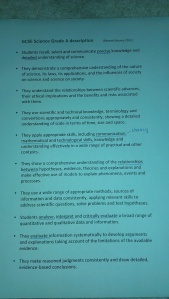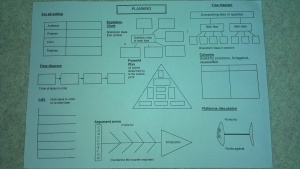This session was hosted by Martin Reece and Stuart Sherman and endorsed by Science Learning Centres East Midlands.
The session covered three main areas:
- Latest update on the new Ofsted framework
- Features of GCSE grades A/A*
- Possible teaching strategies to assist with meeting Ofsted outstanding descriptors while catering to needs of A/A* grade students
My intention is merely to write an account of what was covered and to share ideas that I already use in my own teaching, along with ideas from the session that I will now try to include. If you are familiar with the new Ofsted framework then you might want to skip the first section.
Latest update on new Ofsted framework
The key facts that were shared with us in this section (in numbered italics below) are all drawn from these key documents:
- The framework for school inspection – http://www.ofsted.gov.uk/resources/framework-for-school-inspection
- School inspection handbook – http://www.ofsted.gov.uk/resources/school-inspection-handbook
Key facts
Expect to have very little notice for an inspection
12. The lead inspector will normally inform the school at, or after, midday on the working day before the start of the inspection.
How the ‘quality of a school’ judgement is made
95. In order to make a judgement about the quality of education provided in the school, inspectors must first make four key judgements. These are:
- the achievement of pupils at the school
- the quality of teaching in the school
- the behaviour and safety of pupils at the school.
- the quality of leadership in, and management of, the school
98. In judging the quality of education provided by the school, inspectors will decide whether the school is ‘outstanding’ (grade 1), ‘good’ (grade 2), ‘requires improvement’ (grade 3) or ‘inadequate’ (grade 4). ‘Inadequate’ schools will be judged as either having serious weaknesses or requiring special measures. These will be categorised as schools causing concern.
99. Inspection is primarily about evaluating how well individual pupils benefit from their school. It is important to test the school’s response to individual needs by observing how well it helps all pupils to make progress and fulfil their potential.
Depending on the type of school it may be relevant to pay particular attention to the achievement of:
- disabled pupils, and those who have special educational needs
- those with protected characteristics, as defined by the Equality Act 2010
- boys
- girls
- the highest and lowest attainers
- pupils for whom the pupil premium provides support including:
- looked after children
- pupils known to be eligible for free school meals
- children of service families
- those receiving alternative provision.
Inspectors are not looking for a preferred methodology in lessons (yes, it definitely says that in the School Inspection handbook). They are looking at quality of teaching and progress over time. In other words, they will look through student exercise books to look at quality of written feedback and they will ask your students if the observed lesson is a typical lesson, or if it is ‘different to a normal lesson’.
Stuart then shared with us the grade descriptors for both a ‘good’ and an ‘outstanding’ quality of teaching. See photo below. Our task was to discuss how we can achieve movement from ‘good’ to ‘outstanding’ by careful planning and effective teaching. Many ideas were discussed rather than written, but I did scrawl a few ideas on the document.
Features of GCSE grades A/A*
See the photo below for an Edexcel GCSE Science grade A description (from Science 2011).
The point here was to notice the similarities between the wording of some parts of the Grade A descriptors and the wording of the Ofsted ‘outstanding’ quality of teaching descriptors. The most notable similarities are in the areas relating to communication (all forms of literacy) and numeracy. This of course, brought us nicely on to the next section of the talk…
Possible teaching strategies to assist with meeting Ofsted outstanding descriptors while catering to needs of A/A* grade students
This section firstly spent a little time understanding and working with Bloom’s taxonomy and linking it to GCSE grades. See the next photo.
Given an example exam board specification, we were asked to grade each of the numbered descriptors (in the next photo) using Bloom’s taxonomy.
As you can see, the result was messy to say the least. And this was the point. Exam board specifications are not written to build demand. They are just a list of what students need to know. To plan effective lessons that build on prior knowledge and stretch the more able students, the specifications need to be totally unpicked, and linked to Bloom’s taxonomy so that we as teachers are sure that we are spending the required time on more challenging descriptors. Some schemes of work do the ‘unpicking’ well. Others do not.
As we are expected to, I always share lesson objectives with students. From now on, I am going to (try and) make sure that all of my lesson objectives are graded, and use Bloom’s taxonomy style command words so students can easily track their progress against their target grades. These of course are the command words that students will typically meet in exam papers too.
Now back to the communication mentioned earlier. The rest of the session focused on scientific literacy and the quality of written communication (QWC) questions that exam boards have introduced at GCSE level.
Martin shared some facts from AQA GCSE Science higher tier papers from the Summer 2012 cohort. AQA only have one QWC question per paper. I believe that other exam boards may have more than that (although I am not 100% sure). For AQA, it was not the six mark QWC question that higher ability students performed poorly in, it was their ability to ‘explain how or why’ in 4 or 5 mark questions. This indicates that we as teachers need to teach our A/A* students the meaning of the command words and how to write a clear answer i.e. how to spell accurately, use key words appropriately, construct meaningful sentences with those key words, and write well constructed paragraphs. This again links back to the GCSE A grade descriptors and the ‘outstanding’ quality of teaching descriptor.
Ideas to teach extended scientific writing in the classroom
- Set up a series of questions with increasing demand according to Bloom’s taxonomy, so that students can see the difference in the command words e.g. describe what the liquid in the thermometer does as it gets warmer, explain what the liquid in the thermometer does as it gets warmer.
- Give students a series of key words related to the answer(s), or through class discussion, get them to come up with key words.
- Students discuss and put the key words in a logical order. This could be done as a whole class by having student volunteers hold A4 versions of the keywords and the rest of the class order them, or in pairs/groups by giving out post-it notes that keywords are written on to.
- Allow students to write their answers, encouraging them to ‘pad out’ by including sentences, paragraphs, connectives, etc around the keywords.
- Provide a mark scheme so they can peer mark their work. Use two stars and a wish. That way students can see their current level/grade and how to progress.
- Provide a question with a ‘bad’ model answer. Students identify how to improve it and re-write it themselves.
Stuart and Martin were very much advocating the idea of allowing students to ‘think, talk, then write’ as a mechanism for scaffolding their learning of how to write scientifically. Good exam questions answers do not happen by chance. Students who succeed have typically planned their answers. Stuart and Martin also shared this document that can help students in planning their extended answers. I intend to modify this document and pick out the relevant sections next time I focus on extended writing in Science.
To finish, I’d like to add that I’ve seen plenty of brilliant work on improving scientific literacy by other teachers I follow on Twitter. The one that I intend to use in my teaching is Gavin Smart’s (@GavinSmart) resource called SIXCESS – Gaining Top marks for QWC questions in Science: http://www.tes.co.uk/teaching-resource/SIXCESS-Gaining-TOP-marks-for-QWC-in-Science-6212652/




